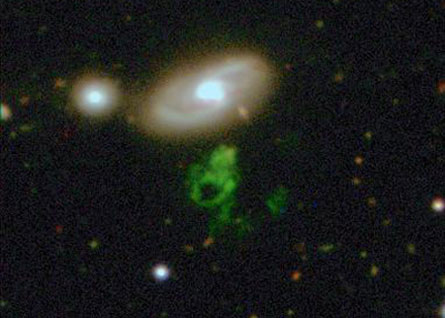Galaxy Zoo’s blue mystery (part 2)
The blue mystery object that I wrote about yesterday may be considerably stranger than I’d first been led to believe. For starters, it’s actually green. But there’s so much more.

“As far as we can tell,” Bill Keel told me this morning, “it’s an unprecedented thing.” Throughout the known universe “there is nothing else that’s quite like it,” according to the University of Alabama astronomer.
For want of something better, Hanny’s Voorwerp is what the research community has taken to calling the mystery cloud (Voorwerp being Dutch for object, apparently, and Hanny is the name of the science teacher who found it while participating in the Galaxy Zoo project). The enigmatic thing radiates a huge amount of light from a cloud of stars, Keel says. The mystery is why.
Yesterday, Alex Szalay of Johns Hopkins compared the Voorwerp to Minkowski’s object. But Keel says that no longer seems a very good comparison. Minkowski’s is a stellar nursery whose starbirths appear to be fueled by radio jets emitted by a black hole in a nearby galaxy. But there seems to be no radio jet associated with Hanny’s Voorwerp or evidence that its stars are infants.
Earlier this year, Keel and other astronomers got the Swift satellite telescope to turn its eye toward the new object. It didn’t take much convincing, Keel says, because Swift is looking for gamma-ray bursts that may occur anywhere at any time. So looking at one patch of the sky is about as likely to prove fruitful as gazing anywhere else.
Swift’s telescope picks up ultraviolet and X-ray emissions. And within a week, Keel says, his group learned that “Swift saw nothing.” If a black-hole-driven quasar was shooting radio waves at Hanny’s Voorwerp, there should have been a strong ultraviolet signature in the object’s spectra, he says.
Keel now suspects that the newfound object is being “lit by the ultraviolet light and X-rays from a quasar that has vanished in the last 100,000 years.” The term for such a ghostly radiance: a “light echo.” The object’s bright glow reflects the size of its star field and the warmth of the Voorwerp — about 16,000 to 20,000 °C.
If not a star-birthing region, what is this new object? That’s the proverbial $64,000 question. Among Keel’s guesses: a dwarf galaxy that got in the way of some bigger, brutish cousin and was pulled apart; or perhaps a dwarf galaxy that got zapped by some quasar that temporarily formed when passing stars fell into a neighbor’s black hole.
Indeed, Keel suggests, the absence of data from the Swift satellite pointing to the source of the Voorwerp’s glow supports this idea that we’re seeing light from a “dead quasar” ricocheting around the small galaxy.
Finally, let’s get to the color of this object. Throughout yesterday’s story I referred to it as blue. In fact, it did look distinctly — and deeply — blue in the many pictures I saw of it on the Web. But that hue essentially reflected some averaging of the output of several of the five filters used in the Sloan Digital Sky Survey that initially photographed it, Keel says.
To depict what galaxies and other objects should look like to the naked eye, the Sloan digital photographs have relied primarily on the output from three of its five filters: the green, red, and near-infrared ones. Most times, this combo will give you a pretty good approximation. But Keel found that the new celestial object emits most of its visible light at a very green wavelength (about 5,200 angstroms).
He cautions that all of the many tantilizing ideas about what the new thing is stem from creative brainstorming in the absence of a lot of solid data. But he’s confident scientists will have more to work from, and soon. On Hanny’s 25th birthday, astronomers learned that they would get observational time on the Hubble Space Telescope during the first half of next year. Proposals are out to scan the Voorwerp with other devices as well.
There’s no question that this enigma is fueling a lot of excitement. For Keel, studying it has developed into “one of the coolest bits of science I’ve done in years.”







